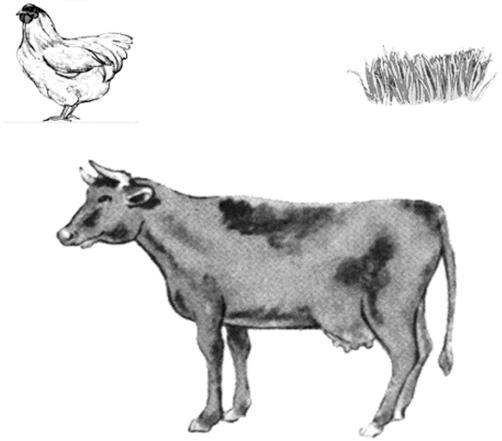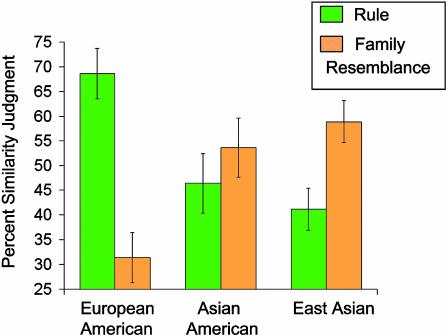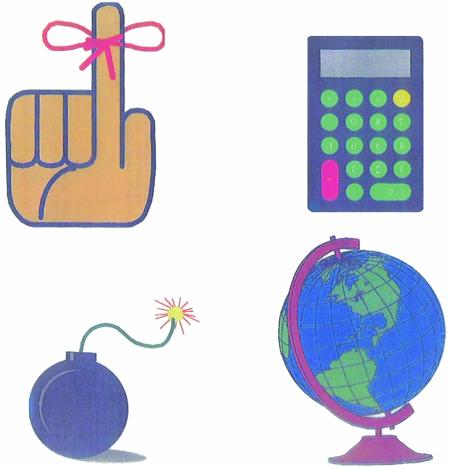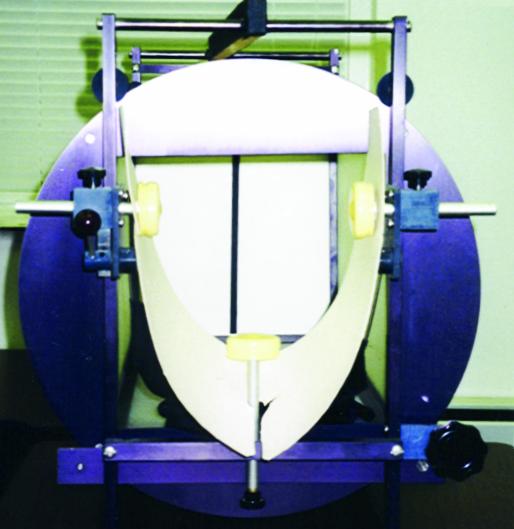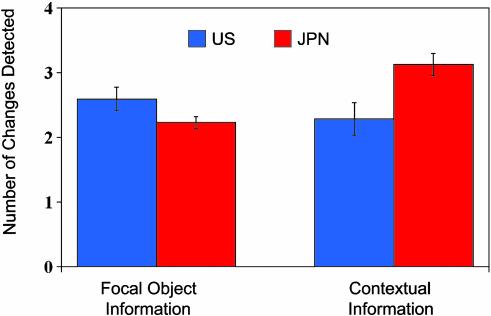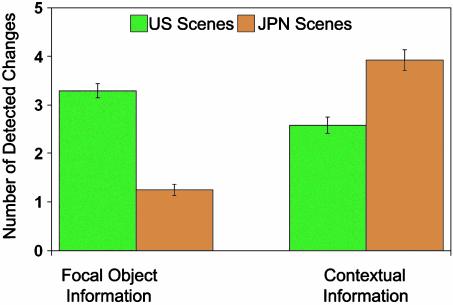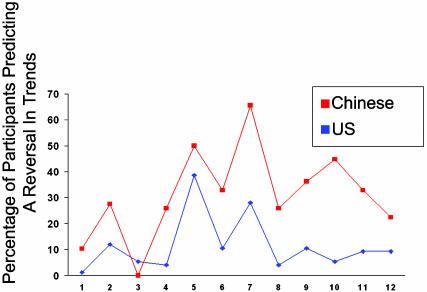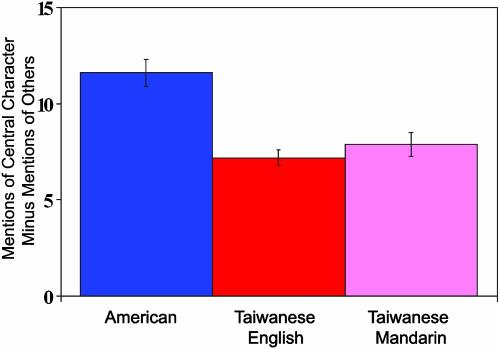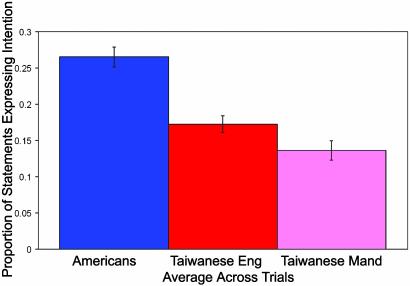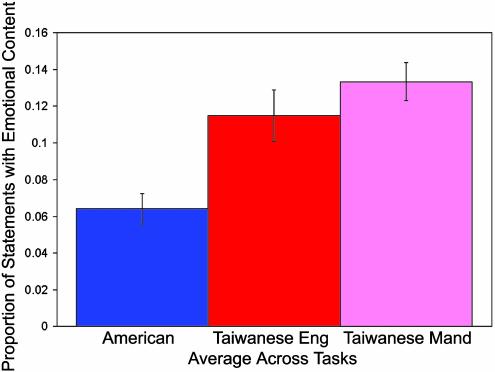Abstract
East Asians and Westerners perceive the world and think about it in very different ways. Westerners are inclined to attend to some focal object, analyzing its attributes and categorizing it in an effort to find out what rules govern its behavior. Rules used include formal logic. Causal attributions tend to focus exclusively on the object and are therefore often mistaken. East Asians are more likely to attend to a broad perceptual and conceptual field, noticing relationships and changes and grouping objects based on family resemblance rather than category membership. Causal attributions emphasize the context. Social factors are likely to be important in directing attention. East Asians live in complex social networks with prescribed role relations. Attention to context is important to effective functioning. More independent Westerners live in less constraining social worlds and have the luxury of attending to the object and their goals with respect to it. The physical “affordances” of the environment may also influence perception. The built environments of the East are more complex and contain more objects than do those of the West. In addition, artistic products of the East emphasize the field and deemphasize individual objects, including people. Western art renders less of the field and emphasizes individual objects and people.
Psychologists and philosophers have long assumed that basic processes of cognition and perception are universal, that inductive and deductive inference, attention, memory, categorization, and causal analysis are the same for everyone in every culture. Historians and philosophers of science, however, have raised the possibility that, at least for ancient Chinese and Greek scientists and philosophers, conceptions of the world and the cognitive processes used to understand it were very different (e.g., refs. 1–3). For example, although the Greeks formalized logic and made use of it for many cognitive operations, including geometry, the Chinese never formalized logic, and indeed, except for two brief periods around the third century B.C., never had much concern with logic at all (4). Presumably as a consequence, the ancient Chinese made little progress in geometry despite the fact that they made great strides in arithmetic and algebra (1).
Another example concerns metaphysics or fundamental assumptions about the nature of the world, together with the cognitive processes that followed from the metaphysical assumptions. The Greeks tended to focus on the object and to explain its behavior with reference only to its properties and the categories to which it belonged. Aristotle explained a stone's falling when placed in water by invoking the notion that the stone had the property of “gravity,” and explained a piece of wood's floating on water by reference to the wood's property of“levity.” In contrast, the Chinese recognized that action always occurs in a field of forces, understood much about magnetism and acoustics, and recognized the true reason for the tides (which escaped even Galileo). The Greeks were inclined to see matter as being composed of discrete objects or atoms, whereas the Chinese were disposed to see matter as continuous substances, even as interpenetrating substances. Finally, the Greeks tended to see stability in the world (e.g., Plato's forms), whereas the Chinese saw the world as constantly changing, indeed, in line with the yin and yang of the Tao, as always being in the process of reverting to the opposite of the current state.
Nisbett and his colleagues (5, 6) have proposed that ancient Greek thought can be described as analytic, meaning that the focus of attention was on some salient object; the properties of the object were assessed and the object was assigned to a category with the intention of finding the rules that governed its behavior. Relevant rules were sometimes of the most abstract kind, namely logical rules, and the focus on the rules governing the object's behavior gave the Greeks a sense of control over the object. Ancient Chinese thought, in contrast, was holistic, meaning that the Chinese attended to the field in which a salient object was located; relationships among objects and events in the field were noticed, but specific object properties and categories were of relatively little interest. Frequently lacking explicit rules about the object's behavior, the Chinese had relatively little sense of personal agency or control. Substituting for logical rules were a variety of dialectical schemas, including finding the “middle way” between two apparently contradictory propositions and recognizing the importance of the context in making judgments about objects and individuals.
Why might the ancient Chinese and Greeks have had such different ways of thinking about the world? Various writers have proposed that the reasons have to do with the differing social practices of the two societies (e.g., refs. 3 and 7). The Chinese were engaged in multiple, complex role relations with other individuals, with the extended family, the village, and the representatives of the state. The socially interdependent Chinese would always have been looking outward, trying to coordinate their actions with those of others while minimizing social friction. And if, as Markus and Kitayama (8) put it, “one perceives oneself as embedded within a larger context of which one is an interdependent part, it is likely that other objects or events will be perceived in a similar way.” The Greeks, on the other hand, were relatively independent, having fewer and less complex social relations than did the Chinese. In addition, the Greeks valued individualism and autonomy. The independence of their lives might have given them the luxury of attending to objects in light of their personal goals in relation to them and might have encouraged them to see objects, both physical and social, as distinct and separate.
If ancient Greek and Chinese philosophers differed from one another because their social systems made it natural for them to see and process the world as they did, then there would be some justification for predicting that modern East Asians (China and the cultures it strongly influenced, including Japan and Korea) might reason differently from modern Westerners (notably the people of Europe and the current and former members of the British Commonwealth). This is because there is substantial evidence that the current social practices of East and West differ in ways that parallel those of ancient times.
The Western-style independent and largely unconnected self is hard for East Asians to comprehend. Philosopher Hu Shih states, “in the Confucian human-centered philosophy man cannot exist alone; all action must be in the form of interaction between man and man” (9). Anthropologist Edward T. Hall (10) introduced the concept of “low context” vs. “high context” societies to capture differences in social relations. The Western self is composed of fixed attributes and can move from one setting or context to another without significant alteration. But for East Asians, the person is so connected to others that the self is literally dependent on the context. As philosopher Donald Munro put it, East Asians understand themselves “in terms of their relation to the whole, such as the family, society, Tao Principle, or Pure Consciousness” (11). If an important person is removed from the individual's social network, that individual literally becomes a different person.
Self-descriptions capture these differences. When asked to describe the self, Americans and Canadians tend to tell about their personality traits and attitudes more than do Japanese (12, 13). North Americans tend to overestimate their distinctiveness (8) and to prefer uniqueness in themselves and in their possessions (8). In one clever study, Koreans and Americans were given a choice among different colored pens to have as a gift. Americans chose the rarest color, whereas Koreans chose the most common color (14).
Training for independence vs. interdependence starts very early. Whereas it is common for Western babies to sleep in a different bed from their parents (or even in a different room), this is rare for Asian babies. Adults from several generations often surround the Chinese baby, and the Japanese baby is almost always with its mother. When American mothers play with their children, they tend to focus their attention on objects and their attributes (“see the truck; it has nice wheels”), whereas Japanese mothers emphasize feelings and relationships (“when you throw your truck, the wall says, ‘ouch’”) (33). Koreans are better able to judge an employer's true feelings about an employee from ratings of the employee than are Americans (15). When we showed participants videos of fish, we found that Japanese were more likely to see emotions in the fish than were Americans (16).
Surveys of businesspeople show marked differences between East and West in concern with harmonious relationships vs. emphasis on individual performance (17). The differential emphasis on relationships can result in conflicts in the world of business. For example, in the mid-1970s, Japanese refiners contracted with Australian suppliers to provide them with sugar for several years at a particular set price. When, the very next year, the bottom dropped out of the world sugar market, the Japanese wanted to renegotiate the price; but to the Australians, a contract was a contract: a fixed, binding instrument that should not be subject to changes in context or by any desire to maintain a harmonious relationship with the purchasers.
If it is really the case that contemporary Asian and Western societies are different in their emphasis on relationships vs. independent action, then it might be the case that Asia and the West differ in their cognitive and perceptual habits along the lines of the holistic vs. analytic stance characteristic of ancient Chinese vs. ancient Greek science and philosophy. For the past several years, we and our colleagues have been examining this possibility in a number of domains.
Cognitive Differences
Our work shows that East Asians and Westerners differ in the way they make causal attributions and predictions, in reliance on logic vs. dialectical principles, and in categorization based on rules vs. family resemblance and categorization based on shared taxonomic labels vs. relationships.
Causal Attribution and Prediction. We might expect that Westerners, like ancient Greek scientists, would be inclined to explain events by reference to properties of the object and that East Asians would be inclined to explain the same events with reference to interactions between the object and the field. There is much evidence indicating that this is the case (for reviews, see refs. 18-20). Morris and Peng (21) and Lee et al. (22) have shown that Americans are inclined to explain murders and sports events respectively by invoking presumed traits, abilities, or other characteristics of the individual, whereas Chinese and Hong Kong citizens are more likely to explain the same events with reference to contextual factors, including historical ones. Cha and Nam (23) and Choi and Nisbett (24) found that East Asians used more contextual information than did Americans in making causal attributions. The same is true for predictions.
Explanations are different even for events involving animals and inanimate objects. Morris and Peng (21) showed participants cartoon displays of an individual fish moving in relation to a group of fish in various ways. Chinese participants were more likely to see the behavior of the individual fish as being produced by external factors, namely the other fish, than were Americans, whereas American participants were more inclined to see the behavior as being produced by factors internal to the individual fish. Peng and Knowles (25) showed that, for ambiguous physical events involving phenomena that appeared to be hydrodynamic, aerodynamic, or magnetic, Chinese were more likely to refer to the field when giving explanations (e.g., “the ball is more buoyant than the water”) than Americans were. The differences in causal attribution therefore probably reflect deep metaphysical differences that transcend specific rules about particular domains that are taught by the culture. In many of the causal attribution studies, incidentally, it could be shown that the East Asian tendency to prefer context was more likely to result in a correct analysis than was the American preference for the object.
Logic vs. Dialectics. When told that all birds have a certain property, people are more inclined to agree that eagles have the property than that penguins have the property, even though, if asked, they would of course say that penguins are birds. Norenzayan et al. (26) showed that Korean participants were more susceptible to this so-called “typicality” effect in deduction. Koreans were also more likely than Americans to be influenced by the desirability of a proposition when judging whether it was logically consistent with propositions to which it was related deductively. A series of studies by Peng and Nisbett (27) showed that Chinese are more comfortable with apparent contradictions than are Americans. They showed that Chinese participants had a greater preference for proverbs that contain an apparent contradiction (“too humble is half proud”) than did American participants (even when the proverbs were Yiddish ones and equally unfamiliar to Americans and Chinese). They also found that the Chinese were more likely to propose “middle way” solutions to inter- and intrapersonal conflicts than were Americans, who seemed to find it necessary that one side or the other had to be correct. When presented with evidence for apparently contradictory propositions, Chinese participants tried to find truth in both, whereas Americans were more inclined to reject one proposition in favor of the other.
Categorization. East Asians have been found to classify objects and events on the basis of relationships and family resemblance, whereas Americans classify on the basis of rule-based category membership. Liang-Hwang Chiu (28) showed triplets of objects like those in Fig. 1 to Chinese and American children and asked them to indicate which of the two objects went together. American children put the chicken and the cow together and justified this by pointing out that “both are animals.” Chinese children put the cow and the grass together and justified this by saying that “the cow eats the grass.” Our research group has found the same sort of differential tendency in college students given word triplets to read. Norenzayan et al. (26) asked participants to report whether a target object like that at the bottom of Fig. 2 was more similar to the group of objects on the left or the group on the right. The target object bears a strong family resemblance to the group of objects on the left, but there is a rule that allows placing the object in the group on the right, namely, “has a straight stem.” Fig. 3 shows that East Asians were inclined to think that the object was more similar to the group with which it shared a family resemblance, whereas European Americans were more likely to regard the object as similar to the group to which it could be assigned by application of the rule. Asian Americans, although closer to East Asians, showed no overall preference. (In several of our studies, we have included Asian Americans. They were always intermediate in their responses and most typically closer to the European Americans than to the East Asians.)
Fig. 1.
“Which two go together?” Item from Chiu (28) test.
Fig. 2.
“Which group does the target object belong to?” Target bears a family resemblance to group on the left but can be assigned to group on the right on the basis of a rule.
Fig. 3.
Percent of participants basing similarity judgments on family resemblance vs. rule.
Attention and Perception Differences
Differences between East Asians and Westerners extend beyond cognition to encompass many tasks that are attentional and perceptual in nature. Asians appear to attend more to the field and Westerners more to salient objects.
Detection of Covariation. If it is the case that East Asians pay more attention to the field, we would expect them to be better at detecting relationships between events. Ji et al. (29) presented arbitrary objects like those in Fig. 4 to Chinese and American participants. One of the objects on the left appeared on the left side of a split computer screen followed rapidly by one of the objects on the right appearing on the right side of the screen. The participant's task was to judge the strength of relationship between one object appearing on the left and a corresponding object appearing on the right. The actual strength ranged from zero, that is, the probability of a particular object on the right appearing was independent of which object appeared on the left, to a relationship equal in strength to a correlation of 0.60. The Chinese participants saw more covariation than did American participants, they were more confident about their judgments, and their confidence was better correlated with the actual degree of covariation. At any rate, all of this was true in the setup just described. When some control over the setup was given to participants by giving them a choice as to which object to present on the left and how long an interval to have before presentation of the object on the right, American performance was entirely similar to Chinese performance.
Fig. 4.
Sample of arbitrary objects shown in covariation detection task.
Field Dependence: Difficulty in Separating an Object from Its Surroundings. If it is the case that East Asians are inclined to focus their attention broadly on the field, then we might expect them to find it more difficult to make a separation between an object and the field in which it appears. Such a tendency is called “field dependence” (30). One of the ways of examining it is the rod and frame test presented in Fig. 5. The participant looks down a long box at the end of which is a rod whose orientation can be changed, and a frame around the rod can be moved independently of the rod. The participant's task is to judge when the rod is vertical. Participants are deemed “field dependent” to the extent that their judgments of verticality of the rod are influenced by the orientation of the frame. Ji et al. (29) found that Chinese participants were more influenced by the position of the frame than were American participants. Although Chinese and Americans were equally confident of their judgments in the setup just described, when participants were given control in the form of being able to position the rod as they wished, the Americans became more confident than the Chinese (and the actual performance of American males improved).
Fig. 5.
Rod and frame test apparatus.
Attention to the Field. We presented 20-second animated vignettes of underwater scenes to Japanese and American participants (16). A still photo from one of the videos is presented in Fig. 6. After seeing each video twice, participants were asked to report what they had seen. The first sentence was coded as to whether a participant initially mentioned one of the salient objects (with “salience” defined as being larger, faster moving, and more brightly colored than the other objects) or the field (e.g., water color, floor of the scene, inert objects). American participants started their statements by mentioning salient objects far more frequently than Japanese participants did. In contrast, Japanese participants began by mentioning information about the field almost twice as often as Americans did. Overall, Japanese actually made 65% more observations about the field than did Americans. And Japanese participants mentioned almost twice as many relations between objects and the field as did American participants.
Fig. 6.
Still photo from animated underwater vignette.
After participants had seen 10 vignettes, they were presented with still photos of 45 objects that they had seen before and 45 that they had not seen. The 45 previously seen objects were shown either against the original background, no background, or a novel background, as seen in Fig. 7. The prediction was that, because they attend to objects in relation to the field, Japanese participants would be more thrown off by presentation of the object against the novel field than would Americans. And this was, in fact, the case. Whereas American performance was literally unaffected by the background manipulation, the Japanese made substantially more errors when the object was seen against a novel background than when it was seen against the original background. (Japanese performance was significantly better for the no-background condition than for the novel background condition, but was not significantly worse for the no-background condition than for the original background condition.)
Fig. 7.
Focal fish previously seen viewed against previously seen background (Left), no background (Center), or novel background (Right).
Change Blindness. Perceptual psychologists have recently been studying a phenomenon called “change blindness” (31). When a picture of a scene and a somewhat altered version of it are presented sequentially, with just a brief pause in between, people can find it very difficult to detect changes that are completely obvious when the two versions are shown side-by-side. This seems to be produced by an automatic tendency of the nervous system to render two highly similar scenes into a single consistent picture, something that the visual system is constantly doing to maintain a coherent view of the world. If it is the case that East Asians attend to the field more than do Westerners, then changes in the field, including relationships between objects, should be easier for them to detect. If Westerners focus more on objects and their attributes, then it should be changes in salient objects that would be easier for them to detect. We presented Japanese and American participants with scenes like those in Figs. 8 and 9, which are stills from 20-second animated vignettes. The scene in Fig. 8 is intended to mimic the object-salience of a Western city and that in Fig. 9 to mimic the field salience, complexity, and interpenetration characteristic of East Asian cities. Other vignettes included an object-salient American farm scene and a field-salient Japanese farm scene. Finally, two scenes were intended to be neutral with respect to culture: a construction scene and an airport scene.
Fig. 8.
Still photo from animated “American” city vignette in change blindness study.
Fig. 9.
Still photo from animated “Japanese” city vignette in change blindness study.
Sensitivity to change was measured by asking participants, after they had seen two versions of the same scene that had changes in both salient foreground objects as well as in relationships between objects and less salient background objects, to tell us which aspects of the scene had changed from the first version of the vignette to the second. An example of an object change is Fig. 8 is a change in the front car's hubcaps. An example of a relationship change is relocation of the buildings in the background. An example of a background object change is a change in the type of buildings in the background. Fig. 10 shows the differences in changes perceived by Americans and Japanese. It can be seen that American participants were more likely to detect changes in salient objects than were Japanese participants, whereas Japanese participants were more likely to detect relationship and environment (context) changes than were Americans.
Fig. 10.
Focal object and contextual changes detected by Americans (US) and Japanese (JPN).
“Affordances” in the Environment. As it happens, the different environments themselves had an effect on the perception of both Americans and Japanese. As may be seen in Fig. 11, when the scenes were intended to resemble American environments, both Americans and Japanese found it easier to detect object changes than field changes. When the scenes were intended to resemble Japanese environments, both Americans and Japanese found it easier to detect field changes than object changes. These findings indicate that environmental factors, known as the “affordances” to perception, may contribute to people's habitual patterns of attention and perception. When the environment affords mostly salient, distinctive objects, it may be that people attend to them to more closely than to the field. When objects are more numerous, more complex, and more interpenetrating, the distinction between object and field may become blurred and relationships and background elements may become relatively salient.
Fig. 11.
Focal object and contextual changes detected in “American” (US) and “Japanese” (JPN) environments.
Of course, these generalizations would be valid only if the scenes that we composed actually capture real differences in Eastern and Western environments. To examine this question, Miyamoto and Nisbett took photographs in front of, to each side of, and behind three kinds of buildings (post offices, schools, and hotels) in towns of three different sizes in Japan and America. Total populations were defined for each type of building in pairs of towns that were comparable in many respects across the two nations: New York and Tokyo, the towns of Ann Arbor, MI, and its “sister city” Hikone, Japan, and the villages of Chelsea, MI, and Torahime, Japan. Buildings were selected at random from the populations of each type. American and East Asian college students were questioned about the photographs, and both groups reported finding Japanese scenes to have more objects and more ambiguous boundaries for objects. Each picture was schematized and assessed for number of objects by using the NIH IMAGE program for Macintosh. An example of a schematized picture is shown in Fig. 12. The number of objects in each picture was assessed based on the number of edges. The more the edges, the more the objects. The average number of objects defined in this way was 32% greater for Japanese scenes than for American scenes. The differences between Japanese and American scenes were marked at each city size.
Fig. 12.
Schematized rendering of a Japanese street scene for the purpose of assessing number of objects.
Esthetics East and West. Among the affordances of the environment that may influence perception are the artistic products of a culture. There are marked differences between Eastern and Western art, and we and our colleagues Richard Gonzalez and Letty Kwan have found comparable differences in the way ordinary college students draw pictures and take photographs of the environment. East Asian paintings take a very broad perspective on the scenes they represent. They tend to put the horizon high as it would be seen by a bird flying over the landscape or an artist perched on a high outcropping. Western landscapes put the horizon low, as it would be seen from the ground. Consequently, less of the landscape is seen. Eastern portrait paintings tend to diminish the size and salience of the central figure relative to Western paintings. The behavior of ordinary contemporary people duplicates these cultural trends. When college students are asked to draw a landscape showing at least a house, a tree, a person, a river and a horizon, East Asian participants placed the horizon higher and drew more objects overall than American participants. When Japanese and American students were asked to take a photo of a person, the Japanese photos showed the person as small relative to the field. An example of the difference between a Japanese photo and an American one is shown in Fig. 13. Japanese literally never made photographs with the person taking up as large a fraction of the total space as the American photo in Fig. 13, but it was common for Americans to do so.
Fig. 13.
Photos showing different ideas of relation between central figure and environment in a portrait. (Left) American portrait. (Right) Japanese portrait.
Change vs. Stability. The ancient Greeks saw stability in their worlds; the ancient Chinese saw change. We have maintained that a contributor to this difference may have been the relative degree of focus on the object vs. the field. If one is attending primarily to a focal object and its properties, and assigning it to an abstract (and static) category, the world may appear to be stable. But if one is attending to a greater number of objects and their relationships, the world may appear to be in a constant state of change. Ji et al. (32) examined assumptions about stability vs. change in several ways. They described various current states and asked whether participants thought the state would continue or change. For example, participants were told about a relationship between a young man and a young woman and asked if they thought it would continue in the future. For each of four events, more Chinese than American participants thought the future would be different from the past. Ji et al. also presented participants with alleged recent trends in various parameters that participants were unlikely to have direct knowledge of, for example, recent trends in global economy growth rates. Participants were shown positively and negatively accelerated growth and decay trends and asked to make a prediction as to what the next time step would be like. For all four types of curves, Chinese participants were more likely to predict that the next time step would halt or reverse the direction of change. It may be seen in Fig. 14. that Chinese participants were more likely to predict reversals of trends in all but 1 of 12 cases.
Fig. 14.
Percentage of American and Chinese participants predicting a reversal in trends. Points 1–3, positively accelerated growth curves; points 4–6, negatively accelerated growth curves; points 7–9, positively accelerated decay curves; points 10–12, negatively accelerated decay curves.
Perception of Everyday Life Events. The experiments reported to this point all use materials that to one degree or another depart from everyday-life objects and events. In a final study to be reported, Chua and Nisbett studied more naturalistic materials. They asked American and Taiwanese college students to describe some personal events (e.g., their first day of the current term), to read some narratives (e.g., about a day in the life of a woman in which everything seemed to prevent her from getting to work) and then summarize what they had read, and to watch videos of silent comedies and summarize them. Taiwanese were randomly selected to write either in Mandarin or in English. The anticipations were that the Americans would make more mentions of the central character than would the Taiwanese and would make more intentional statements expressive of control over a situation or desire to achieve control. Taiwanese were expected to make more comments about the emotional states of various characters. There were no differences in any of the variables due to whether it was personal stories, summarized narratives, or descriptions of the videos that were examined. Thus, we added all three of these together for purposes of analysis. It may be seen in Figs. 15, 16, 17 that all of the predictions were borne out and that the results were the same whether the Taiwanese answered in Mandarin or in English. This latter finding is consistent with the results of several other studies showing that language used, and facility of Asians in English when the testing language is English, are not generally predictive of results (26).
Fig. 15.
Number of statements referring to central figures minus number of statements referring to others, by Americans and by Taiwanese tested either in English or in Mandarin.
Fig. 16.
Proportion of statements with intentional content by Americans and by Taiwanese tested either in English or in Mandarin.
Fig. 17.
Proportion of statements with emotional content by Americans and by Taiwanese tested either in English or in Mandarin.
Discussion
There are marked differences in the cognitive processes of East Asians and Westerners. These include categorization, causal attribution, reliance on rules, use of logic, and preference for dialectical understanding of events. In our view, these cognitive differences derive in good part from perceptual differences, in particular, differences in what is attended to. We have shown that East Asians attend to the field more than do Westerners and that Westerners pay more attention to focal objects. Attention to the object encourages categorization of it, application of rules to it, and causal attribution in terms of it. Attention to the field encourages noticing relationships and change, and prompts causal attribution in terms of the context and distal forces. In addition, attention to the field could be expected to make it difficult to segregate a particular object from a field in which it is embedded.
We believe that the differences in attention, perception and cognition that we have shown are driven by differences in social structure and social practices that prompt Asians to look to the environment and allow Westerners the luxury of attending to some focal object and their goals with respect to it. Sometimes, although not always, these differences may be caused or enhanced by economic factors. We endorse the speculation by others that East Asians emphasize role relations and social harmony as much as they do in part because, since ancient times, they have been primarily farmers, and farmers need to get along with one another (3, 7). In addition, irrigated agriculture, characteristic of much of East Asia since ancient times, requires effective hierarchies, adding more vertical constraints to the vertical and horizontal constraints within the family and village. Such an emphasis on social concerns can might possibly have sustained itself in part out of sheer inertia, for an indefinite period up to the present. The period may be briefer than one might assume, however. Our colleague Harold Stevenson quizzed the mothers of an elementary school in Beijing about their hopes for their children during a 10-year period encompassing a dramatic changeover toward a free market economy. At the beginning of the period, the mothers had primarily social concerns for their children, wanting them to be able to fit in and get along with others. At the end of the period, the mothers had shifted dramatically in the direction of hoping for their children to be ambitious and skilled in ways that would serve them in the new economic circumstances.
The economy of ancient Greece was quite different from that of East Asia. Greece, consisting substantially of mountains descending to the sea, did not lend itself to large-scale agriculture. Common occupations such as hunting, fishing, trading, and keeping kitchen gardens did not require extensive social collaboration. In the absence of substantial social concerns and constraints, attention to a focal object and one's goals in relation to it were luxuries that the Greeks could afford. Many aspects of Western industrial and postindustrial economies in the last 200 years are also characterized by relatively few social constraints, at least for those in middle-class occupations.
Thus, we believe that there is a causal chain running from social structure to social practice to attention and perception to cognition. This account does not accommodate two sets of findings, however, namely those relating to logic vs. dialectics and those relating to what appears to be the differing affordances of Eastern and Western environments, including artistic productions.
A common account of why Aristotle formalized logic is that he got tired of hearing poor arguments in the marketplace and the political assembly (4). Essentially, he was trying to establish that if an argument had a particular formal structure, then it was a bad argument regardless of content. That the Chinese would not have formalized logic, or even have been much concerned with it, can then be explained in terms of the fact that arguments were extremely rare because of the threat that they posed to the social fabric (5). That a dialectical approach to contradiction would have developed fits with this assumption: the Chinese sought the “middle way” between apparent contradictions. This account of logic vs. dialects is a direct one from social practice to cognition that does not make contact with questions of attention or perception.
That the affordances of Eastern and Western environments would differ is more of a puzzle. Part of the affordances are the artistic products that surround the individual. It may be that Asian artists show much of the field because they are capable of attending to a great deal of environmental information and prefer to do so. They may render humans and other salient objects smaller than do Westerners because these are not so focal for them. Ordinary people may make drawings and photos the way they do, and show the artistic preferences they do, in part because that's the way the artworks they are accustomed to seeing usually portray things. On the other hand, given ordinary people's habits of attending to the world, it is far from clear that the examples of artistic products are needed. It is quite possible that at least part of the field preference of ordinary East Asians, and the object emphasis of ordinary Westerners, is due to their respective customary ways of seeing the world.
It is more difficult to explain why the affordances of the built environment would be so different between East and West. One possibility seems unlikely: Eastern environments are probably not more complex simply because of greater population density. The population density of Tokyo is somewhat greater than that of New York, and the population density of Torahime is somewhat greater than that of Chelsea, but the population density of Ann Arbor is substantially greater than that of Hikone, and the East–West differences are roughly comparable for all three city sizes. Perhaps the most plausible explanation of the greater complexity of Eastern environments is that the esthetic preferences match the perceptual focus of each group. Easterners focus broadly on the field and attend to a large number of elements, and they seem to construct environments with a large number of elements. Westerners focus more narrowly on a smaller number of elements and they seem to prefer environments with a smaller number of elements. Our work suggests that these differences operate in such a way as to intensify each other: the environments influence perception and the resulting perceptual preferences prompt people to produce different environments.
Acknowledgments
The research reported here was supported by National Science Foundation Grants SBR 9729103 and BCS 0132074, National Institute of Aging Grant AG15047, the Russell Sage Foundation, and a John Simon Guggenheim fellowship (to R.E.N.).
This contribution is part of the special series of Inaugural Articles by members of the National Academy of Sciences elected on April 30, 2002.
References
- 1.Cromer, A. (1993) Uncommon Sense: The Heretical Nature of Science (Oxford Univ. Press, New York).
- 2.Lloyd, G. E. R. (1990) Demystifying Mentalities (Cambridge Univ. Press, New York).
- 3.Nakamura, H. (1964). Ways of Thinking of Eastern Peoples, ed. Wiener, P. P. (University of Hawaii Press, Honolulu); reprinted (1985).
- 4.Becker, C. B. (1986) Intl. J. Intercultural Rel. 10, 75-92. [Google Scholar]
- 5.Nisbett, R. E. (2003) The Geography of Thought: How Asians and Westerners Think Differently, and Why (Free Press, New York).
- 6.Nisbett, R. E., Peng, K., Choi, I. & Norenzayan, A. (2001) Psychol. Rev. 108, 291-310. [DOI] [PubMed] [Google Scholar]
- 7.Needham, J. (1954) Science and Civilisation in China (Cambridge Univ. Press, Cambridge, U.K.), Vol. 1.
- 8.Markus, H. R. & Kitayama, S. (1991) Psychol. Rev. 98, 224-253. [Google Scholar]
- 9.Shih, H. (1919) Chung-kuo che-hsueh shi ta-kang (An Outline of the History of Chinese Philosophy) (Commercial Press, Shanghai).
- 10.Hall, E. T. (1976) Beyond Culture (Anchor, New York).
- 11.Munro, D. (1985) in Individualism and Holism: Studies in Confucian and Taoist Values, ed. Munro, D. (Center for Chinese Studies, University of Michigan, Ann Arbor), pp. 1-34.
- 12.Cousins, S. D. (1989) J. Pers. Soc. Psychol. 56, 124-131. [Google Scholar]
- 13.Kanagawa, C., Cross, S. E. & Markus, H. R. (2001) Pers. Soc. Psychol. Bull. 27, 90-103. [Google Scholar]
- 14.Kim, H. & Markus, H. R. (1999) J. Pers. Soc. Psychol. 77, 785-800. [Google Scholar]
- 15.Sanchez-Burks, J., Lee, F., Choi, I., Nisbett, R. E., Zhao, S. & Koo, J. (2003) J. Pers. Soc. Psychol., in press. [DOI] [PubMed]
- 16.Masuda, T. & Nisbett, R. E. (2001) J. Pers. Soc. Psychol. 81, 922-934. [DOI] [PubMed] [Google Scholar]
- 17.Hampden-Turner, C. & Trompenaars, A. (1993) The Seven Cultures of Capitalism: Value Systems for Creating Wealth in the United States, Japan, Germany, France, Britain, Sweden, and the Netherlands (Doubleday, New York).
- 18.Choi, I., Nisbett, R. E. & Norenzayan, A. (1999) Psychol. Bull. 125, 47-63. [Google Scholar]
- 19.Norenzayan, A. & Nisbett, R. E. (2000) Curr. Direct. Psychol. Sci. 9, 132-135. [Google Scholar]
- 20.Norenzayan, A., Choi, I. & Nisbett, R. E. (1999) in Cultural Divides: Understanding and Overcoming Group Conflict, eds. Prentice, D. & Miller, D. (Sage, New York), pp. 239-272.
- 21.Morris, M. W. & Peng, K. (1994) J. Pers. Soc. Psychol. 67, 949-971. [Google Scholar]
- 22.Lee, F., Hallahan, M. & Herzog, T. (1996) Pers. Soc. Psychol. Bull. 22, 732-741. [Google Scholar]
- 23.Cha, J.-H. & Nam, K. D. (1985) Korean Soc. Sci. J. 12, 151-180. [Google Scholar]
- 24.Choi, I. & Nisbett, R. E. (1998) Pers. Soc. Psychol. Bull. 24, 949-960. [Google Scholar]
- 25.Peng, K. & Knowles, E. (2003) Pers. Soc. Psychol. Bull., in press. [DOI] [PubMed]
- 26.Norenzayan, A., Smith, E. E., Kim, B. J. & Nisbett, R. E. (2002) Cognit. Sci. 26, 653-684. [Google Scholar]
- 27.Peng, K. & Nisbett, R. E. (1999) Am. Psychol. 54, 741-754. [Google Scholar]
- 28.Chiu, L.-H. (1972) Int. J. Psychol. 7, 235-242. [Google Scholar]
- 29.Ji, L., Peng, K. & Nisbett, R. E. (2000) J. Pers. Soc. Psychol. 78, 943-955. [DOI] [PubMed] [Google Scholar]
- 30.Witkin, H. A., Lewis, H. B., Hertzman, M., Machover, K., Messiner, P. B. & Karp, S. A. (1954) Personality Through Perception (Harper, New York).
- 31.Simons, D. J. & Levin, D. T. (1997) Trends Cognit. Sci. 1, 261-267. [DOI] [PubMed] [Google Scholar]
- 32.Ji, L., Su, Y. & Nisbett, R. E. (2001) Psychol. Sci. 12, 450-456. [DOI] [PubMed] [Google Scholar]
- 33.Fernald, A. & Morikawa, H. (1993) Child Develop. 64, 637-656. [PubMed] [Google Scholar]



